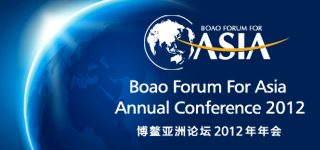Report: China well set among emerging economies
 0 Comment(s)
0 Comment(s) Print
Print E-mail China.org.cn, March 23, 2012
E-mail China.org.cn, March 23, 2012
According to the recently released Boao Forum for Asia's Development of Emerging Economies Annual Report , 2012 [download part 1, part 2], the global economy is still struggling to recover from the economic crisis, with data from the International Monetary Fund (IMF) indicating that the pace of recovery is slowing. However, the report also indicates that a "two-speed growth pattern” is in play, characterized by slow growth in developed economies and more rapid growth in emerging economies.

The IMF indicates that the GDP growth rate of developed economies is likely to drop by 1.6 percentage points to 1.6 percent, while the figure for emerging and developing economies is estimated to be 6.2 percent, falling 1.1 percentage points from the 2010 mark. The major 11 emerging (E11) economies of Argentina, Brazil, China, India, Indonesia, the Republic of Korea, Mexico, Russia, Saudi Arabia, South Africa and Turkey also saw their growth momentum weaken in line with the global trend. Their growth momentum has, however, remained relatively strong, compared to that seen in developed economies.
The report gives several reasons for this. The E11 economies have seen continuous expansion, resulting in an overall improved economic performance. IMF figures show that in 2011, the economic scale of the E11 economies was 25.41 trillion international dollars in Purchasing Power Parity (PPP) terms, 2.4 times higher than the figure posted in 2000. Furthermore, the E11 have continued to strengthen their internal trade links. The first half of 2011 saw internal trade links among the E11 economies rise 28.9 percent year-on-year to US$780 billion, 1.9 percentage points up on their foreign trade growth. In addition, the E11 adopted fiscal policies which were chiefly expansionary in nature, featuring moderate tightening and generally increased fiscal expenditure to stimulate their economies and facilitate recovery. They also made major adjustments in terms of monetary policy.
Comparatively, China posted the best economic performance of 2011, with its economy expanding by 9.2 percent. China was followed by Argentina and India, whose growth rates are expected to reach 8 percent and 7.4 percent, respectively. Brazil performed worst of the E11 economies, with its economy expanding by only 2.9 percent. .
The report also commented that emerging economies would face a number of uncertainties going forward into 2012. Chief among these are a weakening of global demand as a result of continued economic stagnation in developed economies, which could further weaken global demand. This would also affect the prospects for sustainable and stable growth among the E11. In addition, problems could also arise as a result of increasingly closer trade links, which could result in rising trade frictions.
The report concluded by suggesting that, despite these uncertainties, the slowdown experienced by the E11 could stabilize during the second half of 2012. It anticipates that China's economic growth is likely to be about 8.8 percent, and concludes that while China looks likely to avoid an economic hard landing, other economies may not.
Download: 2012 Boao Annual Report: Asia's Development of Emerging Economies Part 1
2012 Boao Annual Report: Asia's Development of Emerging Economies Part 2






Go to Forum >>0 Comment(s)